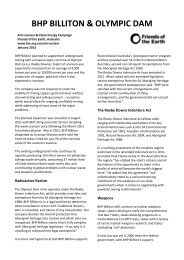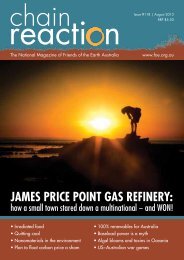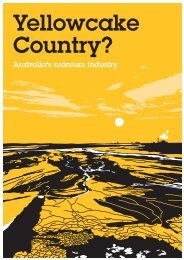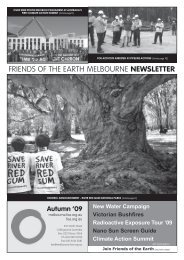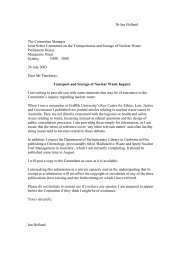Thirty Years of Creative Resistance - Friends of the Earth Australia
Thirty Years of Creative Resistance - Friends of the Earth Australia
Thirty Years of Creative Resistance - Friends of the Earth Australia
You also want an ePaper? Increase the reach of your titles
YUMPU automatically turns print PDFs into web optimized ePapers that Google loves.
overall quality <strong>of</strong> <strong>the</strong> EIS and <strong>the</strong><br />
downright rorting <strong>of</strong> <strong>the</strong> EIS process was<br />
a major issue for FoE at <strong>the</strong> time. I clearly<br />
remember doing commentary on <strong>the</strong><br />
first EIS for <strong>the</strong> Beverley in-situ leaching<br />
project which seemed unable to tell <strong>the</strong><br />
difference between feet and metres, had<br />
columns that were supposed to add up<br />
but didn’t and which claimed that ‘clay<br />
confining layers’ would prevent <strong>the</strong> escape<br />
<strong>of</strong> <strong>the</strong> leach solution despite a detailed<br />
diagram conclusively showing that <strong>the</strong> clay<br />
confining layers didn’t exist. That particular<br />
EIS was unceremoniously rejected. I<br />
believe that it was due to FoE’s efforts that<br />
<strong>the</strong> majority <strong>of</strong> those uranium projects<br />
proposed during <strong>the</strong> 1970s never went<br />
ahead.<br />
A major factor in FoE’s opposition to<br />
nuclear power has been <strong>the</strong> issue <strong>of</strong><br />
reactor safety. The Browns Ferry accident<br />
in <strong>the</strong> USA in 1975, where two large<br />
reactors were brought close to meltdown<br />
due to a fire caused by technicians<br />
checking for air leaks with a candle,<br />
reinforced our belief that reactors were not<br />
safe. What really convinced <strong>the</strong> public that<br />
<strong>the</strong> likes <strong>of</strong> FoE were right in relation to<br />
nuclear power was <strong>the</strong> Three Mile Island<br />
accident <strong>of</strong> 1979.<br />
I clearly remember <strong>the</strong> day it happened<br />
because I was in <strong>the</strong> FoE Fitzroy <strong>of</strong>fice<br />
when <strong>the</strong> phone rang. It was John Speight,<br />
<strong>the</strong> trade-unionist chair <strong>of</strong> <strong>the</strong> Movement<br />
Against Uranium Mining. I had not at that<br />
time looked at a newspaper or listened to<br />
<strong>the</strong> radio and did not know quite what to<br />
make <strong>of</strong> his urgent directions.“Get yourself<br />
a newspaper immediately and I’m picking<br />
you up and taking you to 3CR”.<br />
I didn’t even need to open <strong>the</strong> newspaper<br />
as <strong>the</strong> headline screamed in black letters<br />
‘Death Cloud Spews from Atom<br />
Plant, Women and Children flee’.<br />
I recall that <strong>the</strong> next week was basically<br />
interview after interview.<br />
...................................................................................................................................................................................................<br />
The Three Mile Island accident is largely<br />
forgotten now as it was eclipsed by <strong>the</strong><br />
much more serious Chernobyl disaster.<br />
However it is good to remember that it did<br />
more than anything to halt <strong>the</strong> growth <strong>of</strong><br />
<strong>the</strong> nuclear power industry, especially in<br />
<strong>the</strong> US. In <strong>Australia</strong> it cemented a public<br />
consciousness that anything to do with<br />
nuclear power was indeed bad news.<br />
Three Mile Island was <strong>the</strong> first complete<br />
nuclear core meltdown in a full-scale<br />
power reactor and it happened in <strong>the</strong> USA<br />
where it received maximum publicity. Its<br />
regulatory and safety impact rippled out<br />
over <strong>the</strong> nuclear industry worldwide forcing<br />
increased attention to safety and ultimately<br />
crippling <strong>the</strong> industry.<br />
If Three Mile Island had crippled <strong>the</strong><br />
nuclear industry, Chernobyl was perhaps<br />
<strong>the</strong> Coup de Grace.<br />
When Chernobyl took place in April 1986<br />
it violated everything that we as nuclear<br />
power safety critics had been taught or<br />
thought we knew about nuclear power<br />
plant safety. We would say that ‘A nuclear<br />
power plant can undergo a core meltdown<br />
like Three Mile Island - but a nuclear<br />
power plant can’t blow up like a bomb’.<br />
Seems we were wrong. Nothing prepared<br />
anyone for how bad Chernobyl was<br />
going to be, though a look at some <strong>of</strong><br />
Andrei Tarkovsky’s science fiction movies<br />
might have helped, with lots <strong>of</strong> deserted<br />
industrial wasteland and a spreading<br />
environmental catastrophe.<br />
Chernobyl as a media story seemed to<br />
grow over a period <strong>of</strong> days, with reports<br />
<strong>of</strong> vast amounts <strong>of</strong> radiation coming out<br />
<strong>of</strong> Ukraine, <strong>the</strong> pinpointing <strong>of</strong> <strong>the</strong> radiation<br />
to a specific reactor, a mad scramble to<br />
find out about <strong>the</strong> RBMK reactor type<br />
and <strong>the</strong> discovery <strong>of</strong> International Atomic<br />
Energy Agency reports that vaunted <strong>the</strong><br />
safety <strong>of</strong> this reactor type over that <strong>of</strong> <strong>the</strong><br />
Pressurised Water reactor that had given<br />
us Three Mile Island.<br />
FoE 30 <strong>Years</strong> 23



